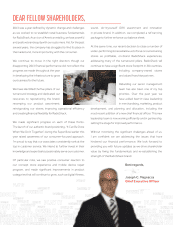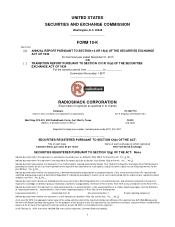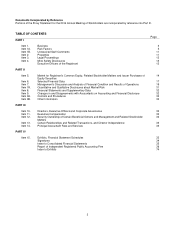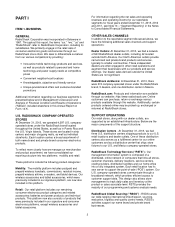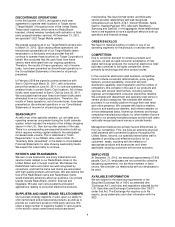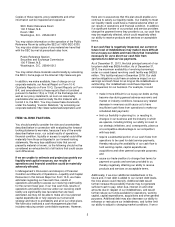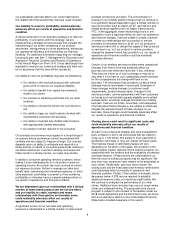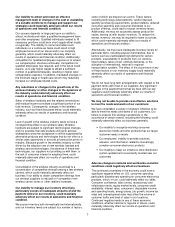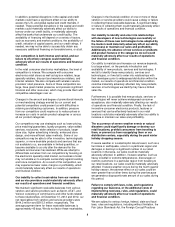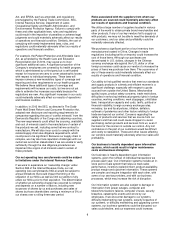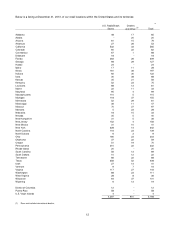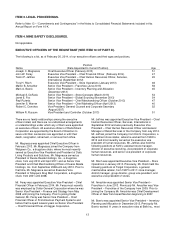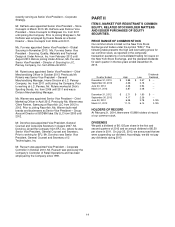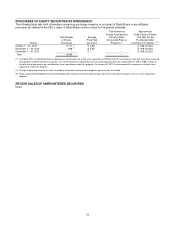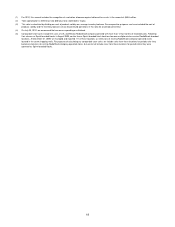Radio Shack 2013 Annual Report Download - page 10
Download and view the complete annual report
Please find page 10 of the 2013 Radio Shack annual report below. You can navigate through the pages in the report by either clicking on the pages listed below, or by using the keyword search tool below to find specific information within the annual report.8
In addition, potential disruptions in the capital and credit
markets could have a significant effect on our ability to
access the U.S. and global capital and credit markets, if
needed. These potential disruptions in the capital and credit
markets could materially adversely affect our ability to
borrow under our credit facility, or materially adversely
affect the banks that underwrote our credit facility. The
availability of financing will depend on a variety of factors,
such as economic and market conditions, the availability of
credit, valuation of capital assets, and our credit ratings. If
needed, we may not be able to successfully obtain any
necessary additional financing on favorable terms, or at all.
Our competition is both intense and varied, and our
failure to effectively compete could materially
adversely affect our results of operations and financial
condition.
In the retail consumer electronics marketplace, the level of
competition is intense. We compete with consumer
electronics retail stores as well as big-box retailers, large
specialty retailers, discount and warehouse retailers, and
Internet retailers. We also compete with wireless service
providers’ retail presence. Some of these competitors are
large, have great market presence, and possess significant
financial and other resources, which may provide them with
competitive advantages over us.
Changes in the amount and degree of promotional intensity
or merchandising strategy exerted by our current and
potential competitors could present us with difficulties in
retaining and attracting customers. In addition, pressure
from our competitors could require us to reduce prices or
increase our costs in certain product categories or across
all our product categories.
Our competitors may use strategies such as lower pricing,
price matching/guarantees, loyalty programs, value-added
services, exclusives, wider selection of products, larger
store size, higher advertising intensity, enhanced store
design, and more efficient sales methods. Some of our
competitors may be able to offer innovative, technologically
superior, or more desirable products and services that are
not available to us, are available in limited quantities, or
become available to us only after the demand for the
products and services has declined. While we attempt to
differentiate ourselves from our competitors by focusing on
the electronics specialty retail market, our business model
may not enable us to compete successfully against existing
and future competitors. As a result of this competition, we
may experience lower sales, margins or profitability, which
could materially adversely affect our results of operations
and financial condition.
Our inability to collect receivables from our vendors
and service providers could materially adversely affect
our results of operations and financial condition.
We maintain significant receivable balances from various
vendors and service providers such as Sprint, AT&T, and
Verizon consisting of commissions and other funds related
to these relationships. At December 31, 2013 and 2012, our
net receivables from vendors and service providers were
$144.2 million and $315.3 million, respectively. The
average payment term for these receivable balances is
approximately 45 days. We do not factor these receivables.
Changes in the financial condition of one or more of these
vendors or service providers could cause a delay or failure
in collecting these receivable balances. A significant delay
or failure in collecting them could materially adversely affect
our results of operations and financial condition.
Our inability to identify and enter into relationships
with developers of new technologies successfully or
the failure of these new technologies to be adopted by
the market could materially adversely affect our ability
to increase or maintain our sales and profitability.
Additionally, the absence of new services or products
and product features in the categories we sell could
materially adversely affect our results of operations
and financial condition.
Our ability to maintain and increase our revenue depends,
to a large extent, on the periodic introduction and
availability of new products, services and technologies. If
we fail to identify these new products, services and
technologies, or if we fail to enter into relationships with
their developers prior to widespread distribution within the
market, our results of operations and financial condition
could be materially adversely affected. Any new products,
services or technologies we identify may have a limited
sales life.
Furthermore, it is possible that new products, services or
technologies will never achieve widespread consumer
acceptance, also materially adversely affecting our results
of operations and financial condition. Finally, the lack of
innovative consumer electronics products, features or
services that can be effectively featured in our retail
locations could also materially adversely affect our ability to
increase or maintain our sales and profitability.
The occurrence of severe weather events or natural
disasters could significantly damage or destroy our
retail locations, prohibit consumers from traveling to
them, or prevent us from resupplying them or our
distribution centers, especially during the peak winter
holiday shopping season.
If severe weather or a catastrophic natural event, such as a
hurricane or earthquake, occurs in a particular region and
damages or destroys a significant number of our retail
locations in that area, our sales could be materially
adversely affected. In addition, if severe weather, such as
heavy snowfall or extreme temperatures, discourages or
restricts customers in a particular region from traveling to
our retail locations, our sales could be materially adversely
affected. If severe weather occurs during the fourth quarter
holiday season, the adverse effect on our sales could be
even greater than at other times during the year because
we generate a disproportionate amount of our sales during
this period.
Failure to comply with laws, rules, and regulations
regarding our business, or the additional costs of
implementing new laws, rules, and regulations, could
materially adversely affect our results of operations
and financial condition.
We are subject to various foreign, federal, state and local
laws, rules and regulations, including without limitation, the
Fair Labor Standards Act, the Foreign Corrupt Practices


